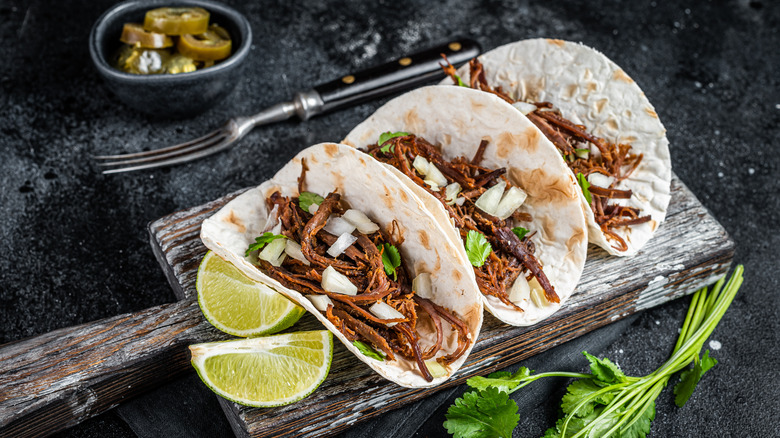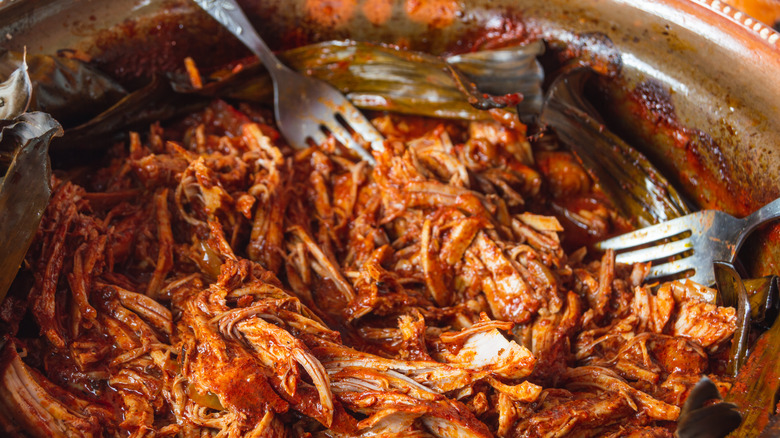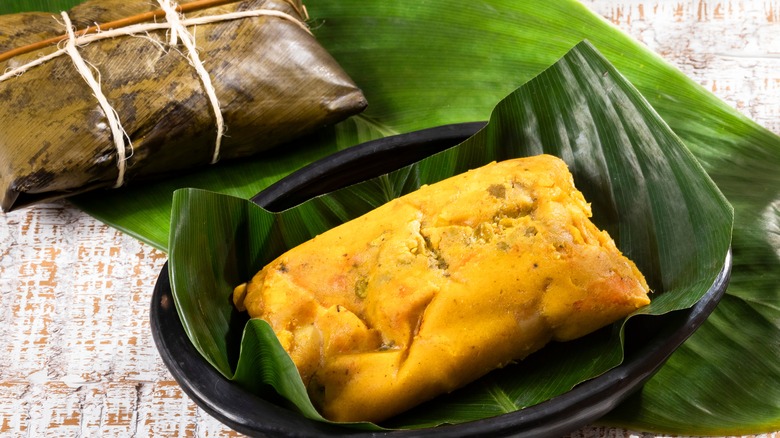The Leaf Liner Tip For Amazing Homemade Barbacoa
One of the defining and tastiest features of well-prepared barbacoa is how juicy and tender the slow-cooked meat is. To achieve this level of deliciousness, try using a leaf liner in your pot, slow cooker, or roasting pan. Lining your cookware and wrapping the meat in leaves will help keep the meat from drying out, while also boosting the flavor. By leaves, we don't just mean any leaves lying around outside. Traditionally in Mexico, barbacoa meat is wrapped in agave leaves, but you'll be hard-pressed to find those at your local grocery store. In the U.S., the most commonly used leaves for cooking barbacoa are banana leaves, which can be found fresh or frozen in most Asian and Hispanic grocery stores, and sometimes mainstream supermarkets in the frozen foods section.
Barbacoa is a popular Mexican dish consisting of heavily seasoned meat — lamb, goat, beef, or pork — that's been cooked slowly and is typically shredded and eaten on tacos. The word "barbacoa" is used to describe both the meat that's marinated in dried chiles and other spices, as well as the cooking style, which consists of slow cooking in a barbecue pit dug in the ground. Although it has a long history in Mexico, this cooking method also has deep roots in the Caribbean, where it is believed to have originated.
Tips for cooking barbacoa in banana leaves
In Mexico, barbacoa (the Spanish word for barbecue) is traditionally cooked by lining a barbecue pit dug in the ground with agave leaves and cooking the meat directly on the leaves. However, this highly effective cooking method is also arduous and labor-intensive. Instead, you can wrap your meat in banana leaves and use your slow cooker or oven to cook the meat. The leaves will help seal in the juices as it cooks, creating the ultimate tender meat for your tacos.
Packaged banana leaves come in various sizes, and extra large pieces can be cut to fit your cookware. It's also recommended to lightly toast your banana leaves to make them more bendable for wrapping your food. This can be done by holding each leaf over a low flame on your stove for about 30 seconds. Line your dish with four or five leaves, depending on the size, or use as many as it takes to cover the entire dish. After adding the meat to the leaf-lined dish, pour the marinade over it, then fold the ends of the leaves over the meat and cover it with more banana leaves, ensuring that it's completely and tightly wrapped in the leaves. If using the oven, cover the entire pan tightly with aluminum foil and cook for about four to five hours on low heat. If using a slow cooker, simply put on the lid and cook on low.
Why should you use banana leaves to cook meat?
Banana leaves are used in cooking in numerous parts of the world — Southeast Asia, Africa, the Caribbean, and South America — basically anywhere banana trees are found. The large, waxy leaves aren't eaten, but are used to wrap food and line cookware for steaming, roasting, and baking. You probably didn't know that banana leaves are an underrated trick for a super moist cake. Not only are they extremely effective at sealing in moisture, but they also give your food a subtly sweet and earthy flavor that pairs especially well with a variety of sweet and savory foods, including flavorful barbacoa. As an added bonus, banana leaves have antimicrobial and antioxidant properties, which could possibly help stave off the development of bacteria and fungi in your food, per the Journal of Food Science.
In addition to wrapping food in banana leaves for baking in the oven or your slow cooker, you can use them as a grill mat for a perfect way to prevent fragile or smaller foods like fish, shrimp, and vegetables from falling through the grates. Your food can be cooked directly on top of the banana leaves on your grill — not only are they useful, but they will enhance the smoky flavor of your food.
Banana leaves are also a great alternative to foil because they are biodegradable and can be composted, as opposed to aluminum foil, which can take between 80 and 400 years to decompose. They can also be stored in the freezer for up to six months and take about 30 minutes to thaw, or even less, if you run them under hot water.


